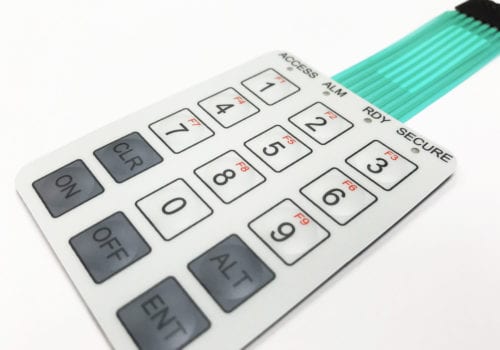Recognizing Membrane Layer Changes: The Secret to Resilient and Trustworthy Controls
Membrane changes stand for a vital facet of modern interface layout, blending performance with strength in various applications. As we explore the ins and outs of membrane layer switches, it ends up being clear that their duty in enhancing control systems is both profound and complicated, raising concerns regarding just how best to leverage their abilities in future technologies.
What Are Membrane Layer Switches?
Membrane switches are an advanced option in the world of customer interface technology, combining performance and style effortlessly. These tools function as a user interface in between users and electronic systems, integrating several components into a compact style. Normally created from adaptable, slim layers of products, membrane layer buttons are created to react to touch, enabling users to communicate with machinery and digital tools properly.
The main aspects of a membrane layer switch include a printed circuit layer, graphic overlay, and a spacer layer that prevents unintended activation. The visuals overlay can be tailored to mirror brand name identification or individual preferences, enhancing looks while making sure functionality. Membrane buttons are frequently used in different applications, including clinical tools, consumer electronics, and commercial tools, owing to their toughness and resistance to environmental elements such as moisture and dirt.
One of the key benefits of membrane switches is their capacity to endure wear and tear, making them ideal for high-traffic settings. Furthermore, they are lightweight and need minimal room, permitting innovative layouts in product growth. Generally, membrane changes stand for a reliable and useful choice for contemporary electronic user interfaces, marrying innovation with user-centric design principles.

How Membrane Switches Job
The procedure of membrane switches depend upon a basic yet efficient system that translates customer input right into electronic signals. These buttons include multiple layers, typically consisting of a graphic overlay, a spacer layer, and a circuit layer. When a customer presses the button, the top layer warps, permitting a conductive component in the circuit layer to make call with a corresponding conductive pad on the bottom of the graphic overlay. This call closes the circuit and sends a digital signal to the gadget, showing that the button has been turned on.
The layout of membrane buttons can vary, however they frequently include domes or tactile aspects to provide comments to the customer, improving the total experience. The materials utilized in membrane layer switches, such as polyester or polycarbonate, add to their resilience and resistance to ecological factors, including dampness and dust. The published circuits are typically enveloped, which shields them from wear and tear over time.

Benefits of Membrane Switches
Among the primary advantages of membrane switches is their versatility in style, allowing them to be tailored to meet details individual needs and visual requirements. This versatility includes various sectors, where different forms, sizes, and shades can be employed to improve user communication and aesthetic appeal.
Additionally, membrane buttons are known for their durability. Built from robust materials, they are immune to dirt, moisture, and physical wear, which substantially prolongs their life-span compared to standard mechanical switches. This sturdiness makes them specifically suitable for high-traffic settings and applications requiring longevity.

Additionally, membrane buttons offer a structured profile, bring about a thinner style that can be incorporated right into different tools without adding mass. This function not just enhances the aesthetic allure but additionally contributes to a much more ergonomic item style.

Applications of Membrane Buttons
Functional and user-friendly, membrane buttons discover applications throughout a wide variety of sectors, including medical tools, consumer electronic devices, and commercial equipment. In the medical area, these buttons are integral to gadgets such as analysis tools, client tracking systems, and mixture pumps, where integrity and ease of cleaning are essential. Their ability to stand up to harsh atmospheres and keep functionality makes them excellent for such applications.
In customer electronic devices, membrane layer buttons are used in products like microwaves, cleaning machines, and remote controls - membrane switch. Their streamlined design enables user-friendly interface, improving the total customer experience while giving sturdiness and resistance to put on and tear
Industrial equipment also gains from membrane switches, specifically in control panels for equipment and automation systems. These buttons provide defense against dust and wetness, guaranteeing constant performance in challenging environments. Their adjustable features permit makers to tailor them to specific functional needs, boosting performance and performance.
Choosing the Right Membrane Layer Switch
When picking a membrane button, it is vital to take into consideration different variables that influence efficiency and suitability for certain applications. The key considerations consist of environmental conditions, responsive feedback, longevity, and style requirements.
First, evaluate the operating setting; buttons subjected to wetness, chemicals, or severe temperature levels require certain products to guarantee durability and capability. Next, examine the need for tactile comments. Depending on user interaction, some applications may profit from a responsive response to confirm activation, while others may like a non-tactile layout for visual reasons.
Sturdiness is an additional essential aspect; membrane switches must be created to hold up against frequent use, impacts, and abrasion. Guarantee the chosen switch can withstand the expected lifecycle, especially in high-usage situations.
Verdict
To conclude, membrane layer switches over function as important elements in the style of long lasting and trusted control systems throughout numerous sectors. Their portable layout, incorporated with durable building and construction and personalized attributes, boosts individual interaction while ensuring longevity in requiring settings. The convenience of membrane layer changes enables for tailored solutions that meet details functional requirements, strengthening their importance in modern innovation. membrane switch. As industries remain to evolve, the significance of incorporating effective membrane layer button solutions can not be overemphasized.
Membrane switches over represent a critical element of modern user interface design, blending capability with durability in numerous applications.Membrane look at this website buttons are an advanced solution in the realm of customer interface technology, incorporating performance and layout perfectly. Normally constructed from versatile, slim layers of materials, membrane buttons are designed to respond to touch, making it possible for users to engage with machinery and electronic gadgets effectively.
The layout of membrane buttons can vary, however they usually incorporate have a peek at these guys domes or responsive components to provide comments to the customer, enhancing the general experience.In verdict, membrane layer switches serve as crucial components in the style of sturdy and reputable control systems throughout numerous industries.